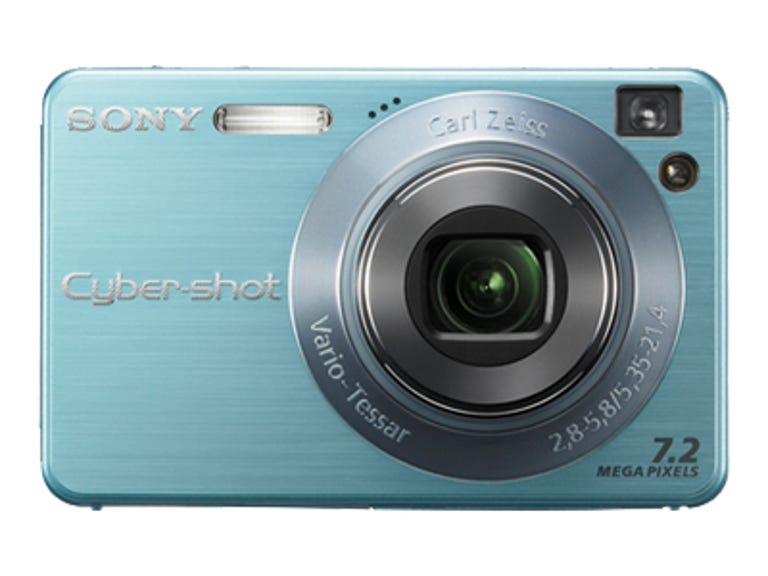 Why You Can Trust CNET
Why You Can Trust CNET Sony Cyber-shot DSC-W120 review: Sony Cyber-shot DSC-W120
Sony Cyber-shot DSC-W120
Sony packs a surprising number of features and color choices in its Cyber-shot DSC-W120, a 7-megapixel shooter that teeters on the fence between budget and fashion. It lacks some of the features of the Cyber-shot T- and higher-end W-series cameras, but offers much more than Sony's budget Cyber-shot S-series. It's a middle-ground camera that stands on its own without catering strictly to budget-minded shoppers or stylish gadget-hounds.
The Good
The Bad
The Bottom Line
The attractive, metal W120 is available in black, silver, blue, and pink versions. Curiously, the step-up W130 only comes in silver, black, and pink. The inch-thick camera weighs just 5.4 ounces with battery and Memory Stick Duo card, and slips easily into most pockets. On the backside of the camera, a 2.5-inch LCD leaves room for a small optical viewfinder, a mode dial, and a handful of buttons. While the small, flat controls feel more comfortable than the last generation W90's buttons, they still seem a bit small for larger thumbs.
The 7-megapixel shooter includes a 32-128mm-equivalent, f/2.8-5.8 lens with Sony's Super SteadyShot optical image stabilization. The lens offers a slightly longer than usual 4x optical zoom, though slight barrel distortion is present at its widest angle. A 9-point autofocus system helps the camera lock onto subjects, and face detection can automatically adjust focus and exposure to suit the faces in your pictures. Adult and Child Priority face detection modes can differentiate between and focus primarily on children or adults in group photos, and Smile Shutter mode automatically captures photos when subjects smile. Sony's Photo Music, an in-camera slide show program, lets users show off their photos either on the camera's 2.5-inch screen or, with an optional video connector, on an HDTV. The slide shows can use a variety of transition effects, and users can upload their own soundtracks to the camera.
Despite its broad feature set, the W120 leaves out many of the onboard retouching and picture editing tools found on most other W- and T-series cameras. Its brother, the W130, comes with several photo filters, such as radial blur, fish-eye lens, and unsharp masking. The W120 can only rotate and resize pictures in the camera. A lot of these in-camera editing features are more flashy than functional, but it would have been nice to include at least a digital red eye removal.
In our lab tests, the W120 performed on par with or slightly worse than the 8-megapixel W130. After a 1.8-second wait from power-on to capturing its first JPEG, the camera could capture a new photo once every 1.3 seconds with the onboard flash turned off. With the flash turned on, that wait more than doubled to 2.7 seconds. The shutter felt quick, lagging just a hair longer than the W130 with our high-contrast target; the W120's shutter lag measured half a second compared to the W130's lagged 0.45 second. With our low-contrast target both cameras performed admirably, each lagging just one second. Unfortunately, the W120 didn't fare well in burst mode, capturing 12 7-megapixel photos in 12 seconds for a rate of one frame per second. The W130 scored double that rate, recording 15 8-megapixel shots in 7.5 seconds.
The W120's photos look crisp, and colors appear neutral and accurate. Close inspection reveals some image artifacts, but they're within an acceptable range for a camera of this class. Noise stays low up to ISO 400, and then noticeable grain begins to develop and starts to obscure finer details, such as small text and the textures of objects. Shots taken at ISO 800 look fuzzy but remain quite usable for both online use and small prints. From ISO 1600 to the camera's maximum sensitivity of ISO 3200, noise obscures or destroys most fine details and the majority of shadow detail is obliterated. While they don't make good prints, these high-sensitivity shots still might be useful for e-mailing or uploading to the Web under the right circumstances.
The Sony Cyber-shot DSC-W120 is a fine compact camera. Its quick performance, good picture quality, and surprisingly robust feature set make it a solid choice in the budget category. However, the Cyber-shot DSC-W130 dwarfs it in nearly every way. For about $30 more, you can get a camera with a higher resolution, quicker performance, and many onboard editing tools. If you're committed to a $200 price tag or just really want a blue camera, the W120 serves its purpose well. If you can spend the extra few dollars, though, make the upgrade to the W130.
(Shorter bars indicate better performance)
(Longer bars indicate better performance)
Find out more about how we test digital cameras.
